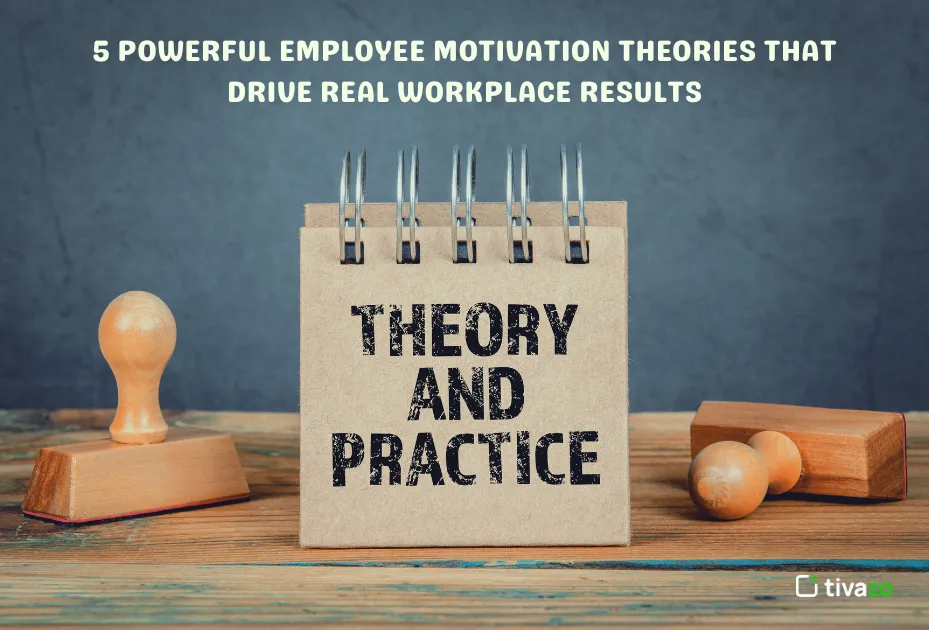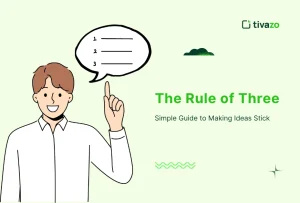Introduction
Employee motivation theories are essential for determining how organizations motivate and engage employees. Understanding employee motivation theories helps leaders unlock the insights of what influences their employees to perform at their best, stay engaged, and work collectively towards the organizational goals. Motivation in the workplace is more than an emotional concept; it is a scientific approach to increasing productivity and retention.
In this article, you will find 5 very useful employee motivation theories, which are accompanied by clear and practical workplace applications. Enabling these theories to frame your leadership can allow you to create an opportunity where motivation can facilitate real-world results and long-term organizational success.
🔑 Key Takeaways: Employee Motivation Theories
- The employee motivation theories help leaders understand what drives performance and engagement.
- Maslow looks to satisfy needs in order; he starts with safety and ends with self-actualization.
- Herzberg attempted to outline hygiene factors (like salary) and motivators (like reward or recognition).
- McClelland discusses the aspects of achievement, affiliation, and power in behavior.
- Vroom emphasized the effort to performance and performance to rewards.
- SDT emphasizes autonomy, competence, and connection.
- Using both intrinsic and extrinsic motivation has led to better outcomes.
- There are some practical ways to use these theories; it’s just a matter of applying them to your company and your team.
- When you apply these employee motivation theories, you can improve engagement, productivity, and reduce turnover.
What Are Employee Motivation Theories?

Employee motivation theories are models that help explain why we do what we do, persevere, and are productive in the workplace. Motivation theories provide an explanation for employees’ motivations and an understanding of the factors that support or inhibit employee motivation, engagement, and performance on the job.
Motivation theories are useful for managers and leaders because they can support clearer and more effective ways to motivate teams, devise incentives, and create a workforce that feels motivated to perform their best, all while striving to have a motivated workforce. Without these theories and/or experience with motivation, it is very difficult to effectively design a motivation plan that actually motivates employees.
Part of realizing a motivation plan involves understanding extrinsic vs intrinsic motivation: what motivates that employee more, and why it is important to your organization. Intrinsic motivation comes from within a person from things like passion, personal development, a sense of accomplishment, etc., while extrinsic motivation utilizes whatever we communicate as a ‘reward,’ i.e., a bonus, recognition, an award, etc., or changes in pay and/or job status. Within motivation theories, both types of motivation appear frequently when examining if and how the two are intertwined to affect employee behavior and performance.
By applying these theories, leaders can better connect with their teams and unlock higher engagement and productivity.
The 5 Best Motivational Theories for Use in the Workplace.

Organizations can utilize different motivational theories to create an environment that inspires employees and boosts productivity. Here are 5 of the most common and relevant motivational theories in today’s workplace.
Motivation Theory 1: Maslow’s Hierarchy of Needs
Maslow’s Hierarchy of Needs is one of the most well-known employee motivation theories. This theory describes human motivation as a pyramid of five levels of needs, from very basic survival needs to the need for personal fulfillment.
Here are the five levels:
- Physiological Needs: The basic needs of survival, such as food, water, safety, shelter, and rest.
- Safety Needs: When the physiological needs are satisfied, people then seek safety and security in their environment, such as job security and safe working conditions.
- Love and Belonging: Once social needs become important to an employee, the need to belong and feel accepted, make friends, and determine the teams to which an employee belongs.
- Esteem Needs: The esteem needs include respect, recognition, and confidence. Employees want to feel valued and appreciated.
- Self-Actualization: The highest of the five levels is self-actualization, which includes a push towards personal growth, creativity, and becoming your best self.
Using Maslow’s Hierarchy of Needs in the Workplace
Using this theory, managers can create motivation strategies based on what needs their employees have and where they can support their employees to move to. Here’s how.
- Physiological: Provide employees with a comfortable workspace, planned breaks, and fair wages so they can cover their basic living expenses.
- Safety: Provide employees with job security, safe workplaces, and all the benefits, including health benefits, insurance, and any other benefits that support safety and security.
- Love and Belonging: Promote teamwork, promote social gatherings, and recognize communication and the ability to openly discuss ideas.
- Esteem: Recognize achievements publicly, provide opportunities for promotions, and offer meaningful feedback.
- Self-Actualization: Encourage skill development and creativity, and allow employees to take on challenging projects
By addressing these needs, companies create a motivated workforce that feels supported at every level
Motivation Theory 2: Herzberg’s Two-Factor Theory
Herzberg’s Two-Factor Theory, one of the most well-known employee motivation theories, divides the factors in the workplace into two categories: hygiene factors and motivators. Understanding hygiene factors and motivators is essential to creating a workplace that does not have dissatisfaction but also provides performance and engagement.
Hygiene Factors vs Motivation
- Hygiene Factors: Do not positively motivate employees if present, but will create dissatisfaction if missing. Think of hygiene factors as basic needs.
- Examples include: salary, job stability, company policies, working conditions, supervision, etc.
- Motivators: Will increase satisfaction and push people to do their best work. In other words, motivators tap into intrinsic motivation.
- Examples include: praise, meaningful work, ability to grow, feeling of achievement, etc.
How This Theory is Relevant in the Workplace
Improving hygiene factors will ensure that employees are not frustrated or disengaged; however, motivating employees requires more effort and investment in motivators. Striking a balance between hygiene factors and motivators is a way for managers to create a sustainable level of productivity.
Workplace Implementation of Herzberg’s Theory
If you want to effectively use this motivation theory in your workplace,
- Improve Hygiene Factors:
- Provide fair and competitive salaries.
- Create clean and safe office environments that are comfortable.
- Make sure there are company policies in place that are easy to access and communicated consistently and clearly.
- Improve Motivators:
- Make it a habit to celebrate individual and team accomplishments!
- Include professional development and training opportunities.
- Empower employees to control their own work and increase their own ownership.
Herzberg’s Two-Factor Theory illustrates employee motivation
Motivation Theory 3: McClelland’s Need Theory
A powerful addition to the list of employee motivation theories is McClelland’s Need Theory. The need theory emphasizes 3 major human motivators that influence employee behavior at work: the need for achievement, affiliation, and power. While all employees are driven by all three motivators, individual employees will be driven by a different dominant motivator, and acknowledging these will help you manage and develop employee motivation more responsively and effectively.
What are the three types of needs?
- Need for Achievement
- Motivation to excel, solve problems, and achieve standards of excellence.
- These employees live for setting and achieving performance goals.
- Need for Affiliation
- Motivation to form connections with others, feel accepted, and work cooperatively with others.
- They prefer the company of others and enjoy working in a group.
- Need for Power
- Desire to influence or control others and take leadership roles.
- They seek authority, recognition, and responsibility.
Why This Theory Is Important to Managers
By discovering which of these three needs is driving the employee, leaders can make adjustments to their motivation strategies. This moves from a one-size-fits-all paradigm to tailored engagement, which is one of the most effective ways to engage employees in today’s workplace.
How Managers Can Apply McClelland’s Theory to the Workplace.
- For High-Achievers:
- Establish stretch, measurable goals.
- Give frequent feedback and celebrate the milestones.
- Create opportunities for personal development and innovation.
- For people who are driven by affiliation:
- Create a team of departments.
- Give collective projects.
- Create mentoring or buddy systems that strengthen relationships.
- For power-oriented people:
- Put them in charge of group projects or to act as a mentor.
- Include them in collaborative decision-making.
- Detail a formal position with a pathway for advancement, and acknowledge their influence.
Understanding McClelland’s Need Theory can help managers tap into the deeper employee motivation by identifying what each team member is, in fact, motivated by, and improve performance, retention, and job satisfaction
Motivation Theory 4: Vroom’s Theory of Expectancy
Vroom’s Theory of Expectancy is one of the most appealing theories of employee motivation, demonstrating the connection between effort, performance, and desired outcomes of performance. Vroom’s theory asserts that employees are motivated to perform when they believe:
- Expectancy – that their effort will create a successful performance,
- Instrumentality – if the performance is good, they will receive a reward they value, and
- Valence – which is an individual requirement for a reward that the employee values.
How It Works Practically in the Workplace
Vroom’s theory recognises that motivation to perform work-related tasks is not automatic – it is based on the employee’s expectation that their efforts in the workplace will lead to a desired performance.
To manage Vroom’s expectation theory for motivation, we need to take several practical actions:
- We need to support expectancy by providing employees with the tools, training, and support for their roles
- We need to manage instrumentality by ensuring that the rewards to be achieved from performance are open and visible to employees, and the criteria are reasonable and consistent
- Finally, we can improve balance by identifying and providing rewards of value to individual employees
Examples
- We have probably all experienced how a sales team that knows their monthly sales target will create a team incentive as a bonus (instrumentality) and feels confident that they have the skills and knowledge to achieve those sales targets (expectancy), even though they have different drivers in their lives. The sales team is motivated by the bonus because they value that bonus (valence).
- There are also many examples in the technology industry, where a developer has been assigned a project he/she is very interested in, with all of the required incentives to perform, plus the developer will want to maintain their involvement in the project.
The examples above and their relevance and simplicity of the expectancy model highlight how we can demonstrate that employee motivation can be measured and take action to ensure that performance leads to meaningful rewards, hence the expectancy theory of Vroom.
Motivation Theory 5: Self-Determination Theory
Self-Determination Theory (SDT) deals with intrinsic motivation, or motivation that comes from within an individual and is not strictly driven by external rewards. SDT emphasizes that employees must have three psychological needs met for them to truly be motivated:
- Autonomy – The employee needs control over the way in which they work.
- Competence – The employee needs to feel that they can do what is desired and effective at it.
- Relatedness – The employee needs to feel supported or connected by others.
Why This Is Important In The Workplace
As a theory, SDT is useful because it helps to explain why just feeling motivated by external rewards typically will not work alone. Employees who feel autonomous, competent, and related will be much more engaged, creative, and productive than those who don’t.
Practical Examples in the Workplace
- Encourage Autonomy: Provide employees choices in how they want to complete a task or how they would like to work (e.g., hybrid or remote).
- Encourage Competence: Provide continual training, constructive feedback, and opportunities for employees to develop skills.
- Encourage Relatedness: Foster a culture of collaboration through team-building activities and encourage open communication.
Self-Determination Theory provides managers the ability to look beyond simple tactics and foster a workplace culture that provides the cornerstone of long-term motivation.
✅ Advantages of Employee Motivation Theories
✔️ Address individual employee needs.
Employee motivation theories underline that not every employee is driven by the same things—some employees want to grow, some want recognition, some want security. This enables managers to lead with empathy and apply strategies based on actual psychological needs.
✔️ Provide frameworks to design a strategy.
Rather than guessing about what works, they provide proven frameworks—leverage the research behind employee motivation theories to establish strategies for better communication, goal setting, and engagement..
✔️ Address both intrinsic and extrinsic motivation.
No matter if the employee’s motivation is from a deep sense of purpose or a performance bonus, employee motivation theories will help you address both internal and external motivation.
✔️ Allow for personalization at scale.
Having frameworks to use, managers can categorize teams according to motivation type, allowing for personalization of strategies, which ultimately leads to increases in productivity and job satisfaction.
❌ Disadvantages of Employee Motivation Theories
⚠️ Potential to oversimplify human behavior.
Not every human behavior will fall into neat and discrete categories. Employee motivation theories may generalize how people behave, but people are complex beings and always changing.
⚠️ Theories may not apply universally.
Certain employee motivation theories, like Maslow’s Hierarchy, may not be culturally inclusive. An aspect that is a priority for employees from one region may not have the same priority elsewhere.
⚠️ Require ongoing updates
The modern workplace, especially with hybrid and remote work, demands flexibility. To stay effective, these motivation models need to be updated regularly to reflect changing values and environments.
Why Learning about Motivation Theories is Important in Ways that Matter

Motivation theories related to employees provide leaders with tools for understanding how different team members are motivated. By using these motivation models, managers can tailor strategies to meet their team members’ individual needs in ways that might mean growth, recognition, or connection.
Real Benefits at Work
- More productive, motivated employees
- Greater engagement through strategy
- Increased retention up when employees feel valued.
Intrinsic + Extrinsic = Total
A balanced strategy uses intrinsic motivators (e.g., purpose, content interest, etc) along with extrinsic motivators (e.g., bonuses, parking spot, etc) to give maximum impact. Employee motivation theories give leaders confidence that they are motivating their team members from all possible perspectives for real results that last.
How to Bring These Theories to Life in Your Workplace
Understanding various theories of employee motivation is one thing, but applying them is what ultimately influences performance. The following is how leaders can utilize the models to create a motivated workplace with high performers.
✅ Step-by-Step Implementation Plan
- Evaluate your team’s needs
- Utilize surveys, one-on-ones, and some feedback tools to determine the primary motivators for each employee achievement, growth, recognition, or connection.
- Apply motivation theories to actions
- Maslow: Ensure basic needs in the workplace are represented (eg, safety requirements/decorum, recognition).
- Herzberg: improve hygiene factors (salary, workplace conditions) and motivators (purpose, achievement).
- McClelland: recognize what the most prominent needs are and assign roles accordingly.
- Vroom: You must set clear goals, using fair and motivating rewards.
- Self-Determination: provide sustenance for autonomy, opportunity to build skill, and collaboration to support common goals.
- Tailor strategies to individuals
- Not every individual can be rewarded, provided feedback, or have a development plan in the same manner. Use the information on employee motivation theories to find a way to reward and assign feedback in a way that is supportive of meaningful or appropriate development pathways.
- Encourage continuous feedback
- It is important to remember that motivation is not static. Be open to communicating with one another, based on how changing needs of your roles or others may shift your strategies of motivation
- Establish the measures for what is going to work
- Establish board reports that provide a baseline for engagement scores, retention scores, productivity scores, or other relevant comparisons to show that at least some of your approaches are relevant.
Conclusion: Unleashing the Power of Employee Motivation Theories
Understanding and applying employee motivation theories can truly change the way teams engage, perform, and develop their capabilities. These theories also provide leaders with tangible approaches to improve morale, productivity, and retention.
To begin implementing, select one or two employee motivation theories and start to apply them using actual workplace situations. Record your observations, obtain input, and modify as needed.
Which employee motivation theories are working best in your organization? Please share in the comments.
FAQ’s
What are the five theories of motivation?
The top five most well-known employee motivation theories are
- Maslow's Hierarchy of Needs
- Herzberg's Two-Factor Theory
- McClelland's Need Theory
- Vroom's Expectancy Theory
- Self-Determination Theory
These theories assist leaders in understanding what drives employees and how they can utilize the correct motivation theories to implement in the correct ways.
What are the 3 major theories of motivation?
Three of the main employee motivation theories are:
- Maslow's Hierarchy of Needs - focuses on levels of human need.
- Herzberg's Two-Factor Theory - distinguishes satisfaction from dissatisfaction.
- Vroom's Expectancy Theory - notes the connection between effort and performance, and the link between performance and rewards.
What is the best motivation for employees?
Different motivators can work for different people. The strongest combination of motivators might be intrinsic (purpose and growth) and extrinsic (bonuses and recognition) at the correct levels of each. The right application of these employee motivation theories mean managers can use the best strategies for individual employees.
Why is motivation important for an employee?
Motivation increases performance, engagement, and job satisfaction. When employees are motivated, overall they participate and deliver work more efficiently, stay with the company longer, and enjoy working in good teams that contribute to a positive workplace culture.




